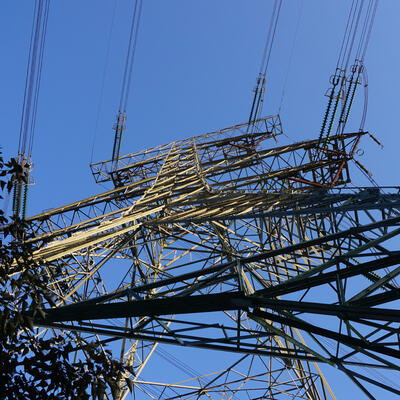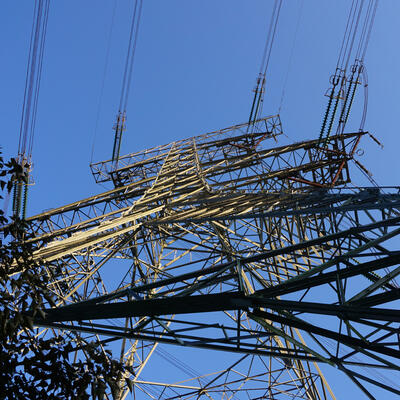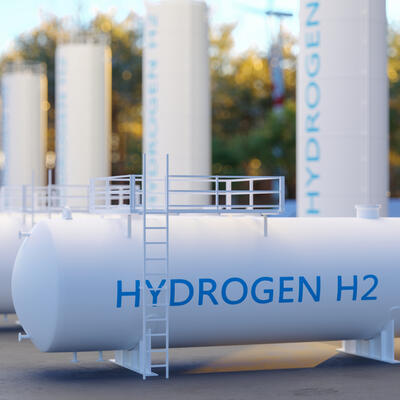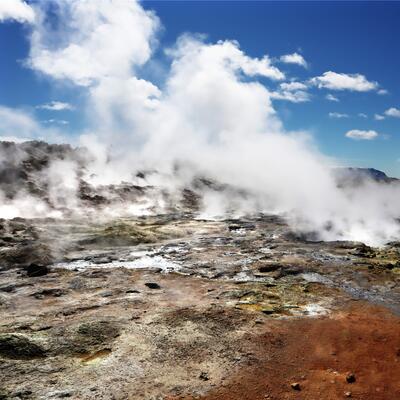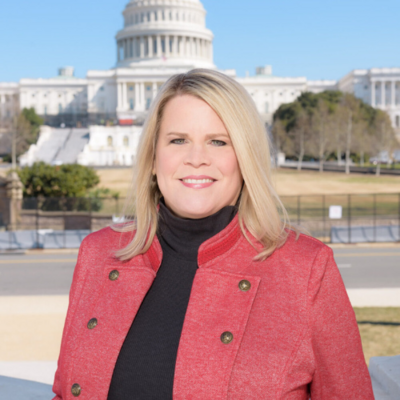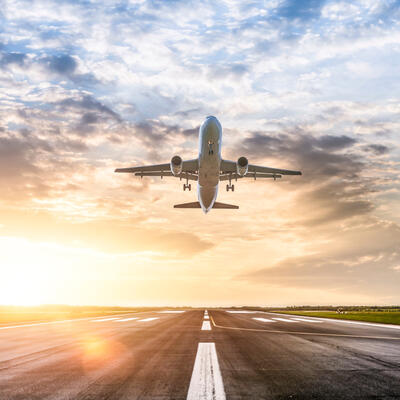
Will Sustainable Aviation Ever Take Off?
Guests

Stephanie Searle

Scott Cary

Fred Ghatala

Christina Beckmann
Summary
For those of us who love to travel, climate guilt weighs heavily. Civil aviation accounts for about 3% of global greenhouse gas emissions, and that number is going up. But while electrifying cars and trucks is already well underway, flying planes on anything other than liquid fuels remains devilishly difficult. Despite that difficulty, there are options. Sustainable aviation fuels, or SAFs, hold the most promise, as they can theoretically drop right into existing engines and infrastructure. Fred Ghatala, Director for Carbon and Sustainability for Advanced Biofuels Canada, says, “Sustainable aviation fuel can be used up to 50% of the fuel blends. Engine manufacturers are making engines that are 100% compatible. So, SAF is like Rudy on the sidelines of the Notre Dame game saying put me in coach I'm completely ready. I don't have any technical limitations. I'm just more expensive. And so, that's part of the role of policy to do it.”
Stephanie Searle, Director for the Fuels Program and the United States Region at the International Council on Clean Transportation, argues that the easiest way to make biofuels isn’t necessarily the best: “For example you could take soybean oil or palm oil and turn it into biofuel, put in a jet – very easy – and that's gonna be one of the cheapest pathways. But that's not gonna get us climate mitigation, because as we use more food crops towards biofuel, we’re diverting them from food and feed markets, which is going to lead farmers to cut down rainforest and convert land elsewhere around the world to produce more crops.”
The second go-to feedstock for sustainable aviation fuels is waste oils and fats,like used cooking oil after frying french fries or animal fats or parts of the cow that we don't like to eat. But as Searle explains, there’s an availability problem here as well. “If we use them for SAF, we’re just gonna be diverting them from biofuel that’s already used in the road sector or from other uses like animal feed and soapmaking.”
Searle does believe there is a sustainable solution, though: “The real long-term solution, and the only one that can be scaled to actually replace a very significant fraction of petroleum demand in aviation, is the very advanced technologies like cellulosic biofuel that could turn things like trash – like literally the trash in your household – into very low carbon biofuel that would get us great climate mitigation gains.”
To bring any of these solutions into widespread use, Fred Ghatala, Director of Carbon & Sustainability, Advanced Biofuels Canada, argues that we need clear policy: “There will always be airlines that are leading by example and blending sustainable aviation fuel, and there's others that will probably never choose to do so if it's not obligated, because it is an added cost.”
While SAFs are clearly the best solution for longer flights, short flights could turn to technology like battery electric or hydrogen fuel cell planes. Scott Cary, Project Manager at the US National Renewable Energy Laboratory, gives insight into the viability of these two options: “At the Lab we’re talking to a different manufacturer pretty much every week from electric to hydrogen and varying sizes up to roughly 70 seats at this point. You've got a market roughly 30% of the market is under 500 miles. And that generally works for both of those technologies.”
Apart from the new promising technologies, what can we do now to limit our carbon emissions when we travel? Christina Beckmann, Co-creator of Tomorrow’s Air and Vice President of the Adventure Travel Trade Association, has some suggestions, “One of the things that has been reminded to me, or encouraged, is fly like a nerd, which is fly newer aircraft, which are more efficient. Fly economy if we have fewer unfilled seats. Choose regular size aircraft. The very small aircraft and very large aircraft are less efficient. And fly direct.”
Related Links:
Tomorrow's Air
Sustainable aviation fuel policy in the United States: A pragmatic way forward
Scientific American
ICCT Report: Vision 2050: Aligning Aviation with the Paris Agreement
Full Transcript
Greg Dalton: This is Climate One. I’m Greg Dalton. For those of us who love to travel, climate guilt can weigh pretty heavily. Civil aviation accounts for about 3% of global greenhouse gas emissions, and that number is going up. But while electrifying other forms of transportation is already in progress, flying planes on anything other than liquid fuels made from oil remains devilishly difficult. That said, there are options. Sustainable Aviation Fuels, or SAFs, hold the most promise. They are already approved at blends up to 50 percent, far higher than the ethanol blends you see when filling up your car. What’s in hese fuels and how clean are they? And how widely are they being used? Later in the episode we’ll talk about whether we should fly at all – and strategies for low-impact travel. But first, we’ll dig into options for decarbonizing air travel.
Fred Ghatala is the Director for Carbon and Sustainability for Advanced Biofuels Canada, an industry association. Scott Cary is a Project Manager at the US National Renewable Energy Laboratory. Stephanie Searle is the Director for the Fuels Program and the United States region at the International Council on Clean Transportation. I asked Stephanie Searle why aviation is such a hard sector to decarbonize.
Stephanie Searle: There are few other options. So, for passenger cars for example, great options on the market for battery electric cars and we’re likely to see that more and more for heavy-duty vehicles as well. We very well may see battery electric hydrogen marine transport. But for aviation it's really hard to electrify. We might see some short-haul electric flights over the next decade or so, maybe some hydrogen. But really, there are fewer options that don't rely on liquid fuels. And so, that's where we’re seeing really the most interest long-term in sustainable aviation fuels or SAF which really just means any kind of fuel that's not petroleum that we think is going to mitigate climate change.
Greg Dalton: Will the industry embrace these changes voluntarily?
Stephanie Searle: Never. Like any industry. Because I mean for airlines cost is such a big issue and in particular fuel cost because aircraft burn so much fuel. And sustainable aviation fuel is more expensive than petroleum, that’s just the reality today. It relies on policy support for the foreseeable future, it's just going to be more expensive. And we know that flyers are also very price-sensitive and are going to be sensitive to the increase in prices if airlines start switching to SAF. So, we’re really going to need policies to push the industry in that direction.
Greg Dalton: Fred, you say that aviation has had a pass for too long. What do you mean by that and why do you think that sustainable aviation fuel is the best way to decarbonize air travel?
Fred Ghatala: Well, I mean by pass that refers to, there's currently no policy on aviation fuel that obligates it to reduce its carbon intensity or obligates it to include renewable fuels. Airlines are using those fuels. However, we’re not nearly at the level that we need to get to climate goals and we’re not at the blend levels that other fuel types like gasoline and diesel have incorporated renewables. So, it's a fuel pool yet to be fully decarbonized where there are a lot of options to do so.
Greg Dalton: Scott, are these fuels ready for prime time?
Scott Cary: It’s readily available technology and it’s something we can do now. It works well with existing airframes that are here for a long period of time. And it works with much the existing infrastructure. There are some challenges there as well in terms of blending and then delivery. But it's a technology we can use right now assume we make it at scale.
Greg Dalton: Fred, one of the areas where sustainable aviation fuel is most use is in California. So, help us understand. Say a person is sitting in a plane at LAX. They look out the window and see a person fueling the plane. How much sustainable aviation fuel is going into that plane in Los Angeles and where does it come from?
Fred Ghatala: I think the best data for that is what the California Air Resources Board publishes. They are the regulator that oversees the low carbon fuel standard, which is the leading policy in the US to reduce transport emissions and get low carbon fuels into the system. So, in 2021 I think CARB reports just over 8 million gallons of SAF being used in California. So, that’s sustainable aviation fuel. So, that's about a quarter of a percent. So, it sounds like big numbers we’re growing from virtually 0 to 8 million gallons. So, great job. But .25% we got a lot more room to go. So, with your previous question is this ready for prime time? So, sustainable aviation fuel can be used up to 50% of the fuel blend. Engine manufacturers are making engines that are 100% compatible. So, SAF is like you know Rudy on the sidelines of the Notre Dame game saying like put me in coach I'm completely ready. I don't have any technical limitations. I'm just more expensive. And so, that's part of the role of policy to do it. So, the fuel’s been blended in California, like there is dedicated sustainable aviation fuel production there. It's one of the leading import jurisdictions where fuel everywhere comes from. So, when it arrives, and Scott knows a lot more the details of how this happens. It generally goes into the co-mingled fuel system at an airport. So, those are the large fuel tanks off to the side they have pipelines running to all the gates. And then it's pulled from the gates through trucks, pump trucks my own term there's something far more technical and goes into the wing. So, it's all the co-mingled fuel set. So, the sustainable aviation fuel goes into the big tanks and then it goes everywhere those pipelines go. So, everyone is getting a little bit of it, but the airlines that are actually buying SAF and selling it to their customers that they opt into corporate programs like United Eco-Skies is one of the leading ones. Then they are the ones that are actually paying for it and get the benefit of using the SAF. It's an accounting process that allocates those fuels and emission reductions to the users into the airlines of it. So, it mixes and that's one of the reasons why the blend percentages can be so high is that sustainable aviation fuel is jet fuel. It’s certified as jet fuel, it's just not from fossil carbon. So, you get jet fuel from crude oil or oilsands that we have in Canada or deep underground, but you can get SAF from so many different feedstocks.
Greg Dalton: And Stephanie, are you as optimistic as Fred about sustainable aviation fuels?
Stephanie Searle: Well, he’s certainly right that you can just drop in 50% to even 100% of these fuels right now, and that the aircraft are ready for them. But I don't think we’re going to see it that quickly and this is important. We can either do this fast or we can do it well. So, there's really three buckets of what people call sustainable aviation fuel, SAF. And people disagree on which of these we should be pursuing. One of them is business as usual, food-based biofuels. So, for example you could take soybean oil or palm oil and turn it into biofuel, put in a jet very easy and that's gonna be one of the cheapest pathways. But that's not gonna get us climate mitigation because as we use more food crops towards biofuel, we’re diverting them from food and feed markets which is going to lead farmers to cut down rain forest and convert land elsewhere around the world to produce more crops. This is something that we've already seen happen with the past 10, 15 years of biofuel being used in the road sector. And it’s been litigated and relitigated, and it's just been a huge controversy and we don't want to repeat that in the aviation space. No one wants that. The second bucket is waste oils and fats. And this is really what a lot of people turn to as the near-term solution for SAF. So, this is things like used cooking oil after frying french fries or animal fats like tallow the parts of the cow that we don't like to eat. But the problem here is well those can pretty easily be turned into SAF. There's a very limited resource of them, and if we use them for SAF we’re just gonna be diverting them from biofuel that’s already used in the road sector or from other uses like an animal feed and soapmaking. So, that really can't be part of the long-term solution either. The real long-term solution and the only one that can be scaled to actually replace a very significant fraction of petroleum demand in aviation is the very advanced technologies like cellulosic biofuel that could turn things like trash like literally the trash in your household into very low carbon biofuel that would get us great climate mitigation gains.
Greg Dalton: Fred, your response to those three buckets.
Fred Ghatala: Yeah, I would say that we are pursuing all of those buckets and that we shouldn't really take any of them and say nope not gonna use that not gonna use bucket two we’re only gonna be bucket three. Because we need sustainable aviation fuel now, we need it yesterday. We’ve got a climate emergency that aviation should definitely play a role in helping mitigate. So, I'd say that you can look at there's ways to do each of those buckets sustainably and it's really important that they stack on top of each other. And Stephanie's totally right. The used cooking oil, vegetable oils, plant oils basically fats, oils and greases are what are in the market now like 95% of the sustainable aviation fuel has been from those feedstocks. And I think they can continue to expand and we can layer other things on top of it. Like used cooking oil. That's a great one. I think we’re only scratching the surface of what's available out there with used cooking oil. China, Africa, like a lot of these, everywhere in the world used cooking oil is not necessarily collected to the degree it should be. So, I think that we can build up a SAF feedstock supply using sustainability criteria and sending it through regulations that have very firm requirements that feedstock should not come from land that has been recently brought into production. You have to have land-use change concerns brought into account and be visible within the system. But we’ve got a lot of different options and we should pursue all of them and we should do so in an environment where there's actually a pull from the fuel supply sector to have sustainable aviation fuels being used.
Greg Dalton: Scott, I remember 10+ years ago there was a lot of excitement about drop in biofuels going to go in existing engines of cars and trucks, that didn't pan out. Is there similar hope or hype now around sustainable aviation fuels? Do you share the optimism?
Scott Cary: So, it’s really a question of scale and feedstocks is where it currently is. And similar to what Stephanie and Fred have said is what is it competing against? Just as an example we're talking to one of our federal colleagues and say we’re working in detail on these different pathways to get to market for biofuels for SAF. And they said, hey, we have to figure out what to do with the Bakers Guild. And I was completely stumped when they said Bakers Guild, I’m like you mean the people that bake things? Yeah, yeah, the bakers, the people who make bread. So, they’re upset because the cost of their oil is going up. And so, rather have the oil available but an expensive cost to make bread. It's that virgin materials being requested to make SAF because they can make money off of it. And I think one place just to add that they're not ready for production right now, but it’s kind of the next generation of fuels is the power-to-liquids. The idea with power-to-liquids fuel is you take a hydrant source and potentially direct air capture carbon or another source of carbon and make a liquid fuel out of it. And I’d be curious to see what others think about that as another pathway.
Fred Ghatala: Power-to-liquids is great. It is going to be hopefully such a large part of liquid transportation fuels, especially aviation fuels. It's one of the types of fuels that has the best hope of doing what renewable energy has done for the power system. Power-to-liquids potentially can be a deflationary source of fuel where the cost goes down because they're based on power. Whereas the fuels from the vegetable oil market even eventually, municipal solid waste like they will have a cost to them that is going to be higher, likely, than the cost to produce low carbon electricity when you know you're producing it at a time when it's not needed elsewhere in the grid. So, it's a great opportunity. It’s certainly over the horizon. So, if we wait for power-to-liquids we’re going to keep emitting a lot more fossil carbon at 35,000 feet with all of the negative environmental consequences that come with that. So, power-to-liquids is great. Should we wait for it before doing anything on SAF policy? Definitely not.
Greg Dalton: Stephanie, that sounds promising and exciting. I hadn't heard of these categories of technology before this episode. What I heard Fred just say is indirectly we could have wind and solar powered airplanes by taking electricity generated by renewables make them into liquid transportation fuels for airplanes. Is that as promising as exciting as it sounds, Stephanie?
Stephanie Searle: So, that’s exactly right. The idea is that you take renewable electricity and use it to split apart water and then combine that hydrogen like Scott said with CO2 that could be directly captured from the air to produce a very low carbon fuel. So, there's great potential there in terms of climate gains. The issues really are in the near-term cost. So, right now this is probably an even more expensive fuel than turning trash or a corn stover into biofuel. And we don't expect to see the cost come down to match that of petroleum until somewhere around the 2050 timeframe. So, it’s gonna be a while until we see really high penetration of power-to-liquids in aviation for the cost reasons. And then another concern is just to make sure that where we are using power-to-liquids that it's coming alongside an expansion of renewable electricity. Because if we don't make sure that it's driving new renewable electricity generation then we might just be using natural gas, electricity and things like that and that wouldn’t be better off at all.
Greg Dalton: And anytime someone says water is involved in a climate solution I get anxious because I live in California there is terrible droughts in the Western United States. So, when you say oh, we need to use water and like, oh, there’s already a lot of water stress driven by climate. So, is it water dependent solution wise?
Stephanie Searle: Well, you know, it uses a heck of a lot less water than growing crops for biofuels.
Greg Dalton: You’re listening to a Climate One conversation about sustainable aviation. Our podcasts typically contain extra content beyond what’s heard on the radio. If you missed a previous episode, or want to hear more of Climate One’s empowering conversations, subscribe to our podcast wherever you get your pods. Coming up, is there a market for battery electric and hydrogen planes?
Scott Cary: We’re talking to a different manufacturer pretty much every week from electric to hydrogen and varying sizes up to roughly 70 seats at this point. You've got a market roughly 30% of the market is under 500 miles. And that generally works for both of those technologies.
Greg Dalton: That’s up next, when Climate One continues.
Greg Dalton: This is Climate One. I’m Greg Dalton, and we’re talking about decarbonizing aviation. Let’s get back to our conversation with Fred Ghatala, Stephanie Searle, and Scott Cary. I asked Fred Ghatala how much airline greenwashing is happening.
Fred Ghatala: Oh, that's a good bull's-eye question. I would say that any airline that is legitimately using sustainable aviation fuel and ongoing operations is not greenwashing; they're doing it. At the end of the day the airlines are the end-users of the fuel. Renewable fuel policies are generally directed at fuel suppliers. So, hats off to airlines that are actually buying SAF blending it they’re paying more than the cost of jet fuel they’re going above and beyond because largely they're not regulated to do so, at least in North America. So, I wouldn't say that's greenwashing. It would be greenwashing if an airline signs up for very severe 2050 net zero targets and then doesn't pursue solutions that are available in the near-term. But at the end of the day it is the job of policy to make these fuels available in the market. You know, there's a phrase in the industry that we need more roads, less roadmaps. It is time to get going and start using these fuels in a way that is significant that actually moves the needle. So, let's get going on it really. So, airlines that are leaning forward, great job, and I think more to come. And the benefit of firm policy is that there will always be airlines that are leading by example and blending sustainable aviation fuel and there's others that will probably never choose to do so if it's not obligated, because it is an added cost. And so, you just have to work it into the system like when I pull up to the gas station and I fill up my vehicle I don't get to choose to save a few cents by going with leaded gasoline. No, it's all unleaded because that's for the benefit of the climate and the benefit of all of us who participate in society. It's good not to have leaded gasoline. So, I think we need to get to a place where aviation fuel is obligated to be less environmentally destructive than it is right now.
Greg Dalton: Right. And leaded gasoline is also about poison brain development and lots of very personal reasons.
Fred Ghatala: And I would say that you know air pollution from airplanes from diesel trucks in underserved neighborhoods cause really significant impacts also. This isn't just greenhouse gasses. There are also a lot of human health impacts.
Greg Dalton: Stephanie, are oil companies and refineries fighting this transition who's on the other side trying to slow this down?
Stephanie Searle: Absolutely, because there's a very good chance that if there were strong policies supporting sustainable aviation fuel that the bill would land at the oil companies. So, that's the way that a lot of biofuel policies work right now. And in the US the main biofuels policies work by requiring oil companies to blend biofuel. So, I'm sure that they're afraid that they're gonna be footing the bill here.
Greg Dalton: Right. In climate conversations we hear that Europe is leading on auto efficiency policies. Is Europe also leading on aviation because, yeah, is Europe also leading on aviation?
Fred Ghatala: On the demand creation side Europe is definitely leading. So, there a refuel aviation EU their new policy proposal that had some significant forward steps just this month in the European Parliament is progressing towards a 2% blend in 2025 and over 80% by 2040 thereabouts. I mean they are taking it quite seriously. They've got approaches that specify fuel types that can be used. it builds on to their renewable energy directive policy that requires certain sustainability criteria. So, they’re creating firm demands the US side with the potential SAF sustainable aviation fuel blenders tax credit is certainly taking an incentive side to try to get those fuels into the market, but we see in a sector in transition. There is firm policy coming out that is sending a signal to project developers to say okay there is a pony here. There's going to be a market that I can produce and sell into. But at the end of the day, the technology is proven the fuels are ready you just can't push a rope. So, policy’s got to provide that pull for the fuels to be used by airlines who are really ready and willing to use it. It's just not that available yet.
Greg Dalton: And Stephanie, one of the reasons that aviation and shipping are some of the hardest to decarbonized is because of their international nature. Planes and ships move around and no one country or state has a real hold on them over, they would say a factory or a refinery. We’re in a situation now where the US EPA had its ability to regulate under the Clean Air Act narrowed, so is this gonna be up to a state-by-state approach but then the state-by-state approach comes up against the commerce clause and saying, you know, states can't regulate things that are interstate. So, what’s the policy context here and what do you see is the most promising policy pathway?
Stephanie Searle: So, Europe is really doing something innovative here on both aviation and shipping. They’re requiring about half of international travel for each aviation and shipping to have some fraction of renewable fuel blending. So, that's the first time that we've really seen something significant addressing fuel use on international travel. But they're moving ahead with it which is very exciting.
Greg Dalton: Scott, we've been talking about sustainable aviation fuels or SAFs which generally refer to liquid fuels that are drop in replacements of jet fuels we’ve been hearing and they’re available today sort of up to 50%. But it's not the only way to decarbonized air travel. What are some other ways they better electric planes, what’s the status of those?
Scott Cary: At the Lab we’re talking to a different manufacturer pretty much every week from electric to hydrogen in varying sizes up to roughly 70 seats at this point. You've got a market roughly 30% of the market is under 500 miles. And that generally works for both of those technologies. And so, we see there’s opportunity there. In the discussions we’ve had with some of the regional carriers, what we call the hub and spoke discussion is the small towns the small rural towns that need to connect into a large hub, that's where the opportunity really is. And to improve on we have a program the US call the Essential Air Service Program that tries to keep service in some of these small communities for business. It’s their only connection unless they drive 3 to 5 hours to a large city. We see a lot of promise there and it’s growing very quickly.
Greg Dalton: Do these small regional airports have the necessary electric power capacity to start recharging a bunch of electric or hydrogen planes?
Scott Cary: So, I think the first thing to think about is most of these locations do not have 20 flights a day. They’ll have two. And so, we did a quick study and looked at essential air service routes with just a nine-seat aircraft out of Denver to rural Nebraska and rural Colorado. And we found that the locations they were flying to weren’t the place where there's an issue with the amount of availability of energy. The place that we saw the concern was when they flew back, banks into the large hub these very large surges in very short amounts of time. And so, that gets into charging charge management requirements a lot of things that can be managed. But the cost is significantly lower once you get that infrastructure in place. We see there are some opportunity there. There are two manufacturers that are moving fairly quickly. They’re hoping for 2026 to be flying. But then there’s a scale factor from there to where they have to build those aircrafts for their airlines to use on those small routes. It’s not gonna replace the medium or long haul anytime soon but it’s another piece of the puzzle.
Greg Dalton: That’s exciting. not long-ago people would've dismissed the possibility of battery-powered airplanes. So, that's promising. Scott, how about hydrogen fuel cell planes. One of the advantages of the hydrogen advocate, say for cars is they can refuel a lot faster than electricity. So, how about hydrogen planes?
Scott Cary: If you talk to our hydrogen program lead. He jokingly will say I can charge much faster than you can with your electric vehicle. He likes to say that. Because generally the charging speeds for hydrogen are getting on par with moving liquid petroleum. Now it’s just a storage and delivery systems go with that in addition to the hurdle of getting a vehicle certified. So, there’s still a lot of challenges there but there’s also some opportunity.
Greg Dalton: So, people might be able to fly on an electric plane in just a few years, all sorts of innovation happening. Stephanie, it's been 20 years since the Concorde flew its last flight. Now several companies are striving to bring back supersonic aviation. These new planes use massive amounts of fuel and these companies say they will rely on sustainable aviation fuel we’ve been talking about that doesn't now exist. What do you think of this new push for supersonic travel?
Stephanie Searle: Now that I would call greenwashing, because supersonic travel burns 5 to 7 times more fuel per passenger per kilometer than a regular aircraft. And we already talked about how sustainable aviation fuel is going to be more expensive than petroleum fuel and that’s gonna hurt airlines' bottom line. Now, just multiply that by 5 to 7 times no one is gonna pay for that.
Greg Dalton: But we live in a world where one person has a lot of money to throw around and money to burn. I could see them buying a crazy expensive ticket to fly to New York to London in what, three hours. Fred, there is a pathway that says that elites can buy down technology, you know, that was Tesla's model to make an electric car and then more affordable car. How do you see the prospect of more supersonic aviation that would mean a lot of biofuel buyers potentially for your association?
Fred Ghatala: That's right. Look, when it comes to air travel I love to travel. The idea of traveling farther and faster is extremely appealing. However, it's got to be done in a way that's environmentally, socially responsible. It looks like we have the tools to do that with sustainable aviation fuel with the seven pathways that are certified by ASTM, the technical certification body for jet fuel. And there's many more hundreds more that are approaching finalization that are in the pipeline to be fully certified. So, if we can stop burning fossil carbon in the jet fuel. If we can stop adding greenhouse gasses to the atmosphere through combusting jet fuel. I think planes should fly five times as fast and use five times as many fuels. Obviously, someone's going to have to pay for that. I don't see the entire sector shifting over to supersonic. I'm sure there's a lot of issues with it when you extrapolate that to it being a predominant source of travel, but it should be an option because I think we love to travel as a species. There are tremendous economic and social and wellness values from being able to travel, whether it’s short distances using electricity and hydrogen, or super long distances, superfast using supersonic. So, if we can just remove the environmental impact from that we should pursue it, but we should be sure that we can remove the environmental impact from it. It shouldn't be a build it now and then we’ll decarbonize it later, no. It’s got to be part and parcel because we've kind of gotten into the redline part of when we must absolutely do something to get to 1.5° so we can’t add something. It would be completely irresponsible to add something that just ups the fuel burn at even higher altitude than current commercial dream liners fly and do so in a way that's trust us we’ll decarbonized it’s got to be part and parcel. And I think you see Boom Supersonic and others that are really signing up for using carbon neutral, if not carbon negative fuels. So, I think folks get that and I totally agree with you Greg, like the one percent will do whatever they want, so we may have like private wheels up style supersonic jets. And that really sounds like a lot of fun to be honest.
Greg Dalton: Let’s get out your crystal balls and ask you of the pathways we’ve been talking about five, 10 years out what are we gonna see in aviation. How much electric hydrogen fuels and what type?
Stephanie Searle:Ten years out I think we’re well less than 1% in terms of electric and hydrogen aircraft more perhaps after that point. And in the US, I think we could maybe get up to a couple percent blending of biofuel. But what I'm really afraid of is that the easy way out is gonna for that to be food-based biofuels that are going drive deforestation and not get us any closer to our climate goals.
Greg Dalton: Fred, what’s in your crystal ball 10+ years out?
Fred Ghatala: I think it's in all of the above strategy. I agree with the penetration rates that Stephanie suggested for electricity and hydrogen, but I think if we can get more towards 30% of sustainable aviation fuel blend and jet fuel that would be a significant progression. The specs take it to 50%. You can blend up to 50%. However, if you get up towards that upper end of the specification you have to change the fossil jet fuel that you’re blending with to make sure you have a sufficient amount of aromatics in the jet fuel. Of course, different SAF sustainable aviation fuel pathways have different aromatic profiles, but I think we’ll be just shy of the max blending specification. Yes, aircraft manufacturers and engine manufacturers are doing 100% sustainable aviation fuel compliant jet engines, but if only some of the planes can take 100% SAF and others can't, and they’re all hooked up to the same fueling infrastructure, we’re gonna have an issue where some fuels can go to some planes and others can't. And that's not going to work with aviation. So, I think we’ll be hopefully above 30%. And I think that clear signals that that is where we’re going, not voluntarily, but through stepwise year-by-year additive regulations are what are going to be the required signal for sustainable aviation fuel project developers to invest and importantly for feedstock suppliers to invest because these aren’t markets that we just flip on and flip off; we’ve got to build them. And so, that sends the right signals to farmers to foresters to everyone else in the feedstock supply chain to start producing more in an efficient manner. And also, we need to just be more efficient with everything we do related to biomass. There is no reason why we should be wasting as much as we do when this stuff is extremely valuable and important to our mobility, our nutrition and all other types of needs that make life possible right now.
Greg Dalton: Fred, Scott and Stephanie, thanks for coming on Climate One to talk about the future of aviation.
Fred Ghatala: Thanks for having us.
Greg Dalton: This is Climate One. I’m Greg Dalton. We’re talking about sustainable aviation and travel. Mark Twain once wrote “Travel is fatal to prejudice, bigotry, and narrow-mindedness, and many of our people need it sorely on these accounts.” Traveling is a great joy, creating experiences and memories that last a lifetime. Unfortunately, tourism overall is also the cause of about 8% of global greenhouse gas emissions. That can be a difficult guilt to carry for anyone who understands the reality of the climate crisis. I asked Christina Beckmann, Co-creator of Tomorrow’s Air and Vice President of the Adventure Travel Trade Association, how she reconciles working in the travel industry while also caring about the climate.
Christina Beckmann: Yeah, I mean I have grappled with this a lot in my professional career. I've got 20 years in sustainable tourism. I always felt like I was on kind of the right side, you know, we were advocating for nature and ecotourism, where the funding was supporting conservation projects and local cultures. And I never saw really the contradiction until you know climate was like this drumbeat in the background the last 10 years. And we were doing research papers on adventure travel guides for example, on the front lines of climate. So, we saw this kind of moving like, hmm, I wonder about these emissions. I wonder -- and I wrote a paper years ago that sort of explored the crux of this like travel does so much good on the ground. We do we are and we think about the biodiversity crisis our travel revenues are supporting biodiversity in places where they depend on tourism revenues for that. So, there's all the good on the ground and yet all the problem in the air. The emissions from not only you know flights get a lot of attention. But if you look end to end at the emissions of travel. There's a study that came out in 2018 that said, 8% of global emissions come from travel. And that’s lodging, meals, accommodation, shopping, transport, and we find that the people who do the most travel are affluent people and they go places and they have sort of high demands. So, that sort of central contradiction is actually what is underneath Tomorrow's Air this carbon removal collective we initiated. Because I felt like to have integrity and to be able to sleep at night, we would have to be doing all we can to support carbon removal solutions that can help us sort of reconcile this conflict.
Greg Dalton: How did you personally become a climate conscious traveler? What was your aha moment?
Christina Beckmann: My aha moment was in Antarctica, actually. I mentioned the sort of this growing realization, but in 2018 I had the opportunity to travel to Antarctica as part of an expedition with Robert Swan who is the he says he’s the only guy crazy enough to walk to both the north and south pole. And he has this foundation called the 2041 foundation and that is the year that the Antarctic Treaty expires. And he believes that if you can get people to Antarctica to understand its importance as a place of peace and science. Then when 2041 comes around. We will be in position to protect it. So, I was on this expedition with his foundation and a travel company called the Explorers Passage and the programming on that involved climate lectures and also of course trips out in the zodiac in this through the brash ice and the whales and the penguins and also this you know it was jarring to be some places that were sunny and iceless. And when I spoke with other people who I know who've been to Antarctica they were surprised at how far we were going in the archipelago. And that, you know, it was impossible to be there and not, you know, there I was having an adventure travel experience trip of a lifetime and all throughout the day we would have sort of climate lectures. And then in the afternoon they would put you in kind of workshops I felt like I was a little bit like I don't know Antarctic business school summer camp. And the workshops would be like work in your team to come up with a solution to, you know, fill in this problem. So, that I really took everything there to heart and kind of came back and was like what is my how can I use my platform. We all have a platform, we all have a sphere of influence, and so I thought, what can we do in travel even though you know I'm at the Adventure Travel Trade Association. We are not a massive multimillion-dollar organization but we have a voice, we have a platform. So, that was really the catalytic moment for me was to be in Antarctica and feel it and also be learning some basic facts that I actually didn’t have.
Greg Dalton: Yeah, very parallel to my experience where I learned that went from an obstruction and intellectual idea of something far away to being a lived experience that you touch and then breathe that becomes really real. So, it sounds like you're saying we shouldn't just stop traveling if someone's a climate conscious traveler, what should they do? What are your recommendations beyond flying less?
Christina Beckmann: Well, so make those trips meaningful. Think about your flight and there are ways to book climate conscious flights. One of the things that has been reminded to me or encouraged is fly like a nerd, which is fly newer aircraft, which are more efficient. Fly economy if we have fewer unfilled seats. I know flying economy is hard especially if you can afford to fly higher and you're going further. Choose regular size aircraft. The very small aircraft and very large aircraft are less efficient. And fly direct. And I think when you get into places you should really ask questions and look at where you're staying and what kind of energy. You know, our association does events in destinations around the world. We now ask our host convention centers and hotels. Where does your energy come from, how are you handling food waste? How are you handling water? I mean there's a lot in there that can reduce your footprint surrounding not just the flight.
Greg Dalton: When searching for a flight on Google they highlight the lowest emitting flights. Do you know about that, what's underneath that because that was new to me when preparing for this episode?
Christina Beckmann: Yeah, those calculations I mean there’s a lot of, when you get really into the weeds of the emissions associated with different flights and the mechanics. So, people will argue over what math is being used underneath. So, anyway, yes, Google has that you can look at that. It's great to know. I think it's terrific to know what your emissions are and take those into consideration. You can then choose to fly a different route. You might choose to take a train, especially summer time is a lot of people are going to Europe. I recently got switched on to this thing called Seat 61. If you go there, he's a hobbyist. It's the man in Seat 61, and it's all about trains and the best train connections and how to link trains throughout Europe and it's a highly recommended website run by a hobbyist guy who loves trains.
Greg Dalton: When I buy a ticket online there are sometimes an option to pay an extra $50, $20 or so depending on the distance.do you trust those offsets that airlines are selling?
Christina Beckmann: The offsets have been much-maligned, I think, and there have been some bad actors in the realm of carbon offsets. I however do think that most of what you see on airline websites for example, in preparation for this I was looking at what some of Alaska Airlines offsets are. If you dig in there, they’re supporting a forest in South Carolina, an 18,000-acre bird and wildlife sanctuary. I’m okay giving $20 to that. They are supporting a forest in Alaska, part of Prince of Wales Island in the Alaska Panhandle. These projects, most of which you’re gonna see on an airline, are going to be Verra Gold Standard verified projects. And I think putting money to support those worthy projects is worth it. The thing to remember in there though, the complication with offsets is that it leaves you with the feeling that you’ve solved the problem. Oh, I balanced it out. I'm even; we’re good. The reality is we’re not good, we're way over what we need. So, you've emitted that CO2 it's going to stay in the atmosphere until we remove it. We have trillions of tons of stored CO2. If everything stopped today. If we all stopped completely, it would take 900 years for natural systems to cycle through all the CO2 that’s stored in our atmosphere today. So, the challenge with offsets is that it leaves you feeling like you've solved something. When what you've done is something helpful and we still have this whole other category of work to do, which is dramatic reductions and carbon removal.
Greg Dalton: So, that’s why in carbon direct removal. We’ve done episodes on nature does that technology is doing that. It's expensive. It's early days it’s getting a lot more attention. So, are you trying to create a revenue stream for carbon removal to address that legacy carbon that’s up there?
Christina Beckmann: That’s it. That’s exactly it. We are trying to rally travel to help generate demand for carbon removal innovations. Tomorrow's Air is partnered with Climeworks right now, which is a direct air capture carbon removal provider. We’re adding other hybrid tech and tech solutions into our portfolio. Back to offsets, when we want to be carbon neutral when we’re balancing our emissions that sends us down a path looking for the lowest cost offset. And that has caused us over many years to ignore investments in these removal technologies which we know we need. And the way to bring those costs down is to deploy them. There's this very well documented learning rate with technologies. And as you deploy them further, they become more efficient and less expensive. And so, today Tomorrow’s Air is doing this by trying to bring travelers and travel companies to the cause; we’re not the only ones out there, right, like Shopify and Meta, Alphabet. These companies are saying we’re gonna spend on carbon removal technologies at any cost. Things that are high cost, low volume today but have the potential to be low-cost, high-volume in the future. And we don’t know that these are all the perfect solution. Nobody's proposing that a direct air capture is the only solution. It's one of many, you know, that’s why I would still as an individual contribute to carbon offsets contribute to valuable nature solutions, we know we have to have that plus we love nature like where we gonna go hike and play and ski. And, you know, these are sacred spaces there are so many reasons to support that kind of thing. And if we can help stimulate demand for some of the technologies, we will have the midscale when we really, really need them.
Greg Dalton: I guess I get the reason or the logic of large corporations with a lot of money buying down the cost of direct air capture that’s about 200 times more than other offset programs. I just wonder about retail travelers if that's the best use of their funds or that $15 or $20 per flight might be better spent on the offsets of today. I buy them sometimes; I double by them because I’m not sure that they’re a hundred percent effective. So, I’ll spend $30 instead of $15 thinking like, oh, I’m doubling, you know, little bit of insurance for any kind of questions about the effectiveness or the additionality of those offsets. So, is this the best way to direct retail consumer dollars?
Christina Beckmann: Right. Well, I think thinking about it in terms of the best. When we put ourselves in a mindset of what is the best use of this one dollar. The best use of that one dollar is across the spectrum of solutions. And so, I firmly believe that individual travelers should engage with carbon removal tech. That signals it's not just the financial contribution that we can make en masse that can be meaningful, but it also we are engaging with the subject and it signals to policymakers and investors that there's a public that cares and is looking at this.
Greg Dalton: It’s not just about the money, it's about dollars. Attention follows dollars, right.
Christina Beckmann: I am firmly of the mindset that we are all in this together. We are all co-conspirators in our climate crisis we all got us there and now we all have to kind of dive in and help get us out. But what I have learned is that people like to take action. People like to engage. I feel much better feeling like I'm contributing than sitting here wringing my hands and hoping that the tech bros and you know the, we have a president right now who's in favor of climate but who knows who’s gonna be our president in the next few years, you know. Waiting around for governments and richer people to take action I find very aggravating. And so, it feels good actually to kick in and be part of that movement.
Greg Dalton: Earlier in this episode we talked about sustainable aviation fuels and learned there are only a quarter of a percent of the fuel makes and that’s in places like California, where there's something of some pressure and a market that’s more oriented toward ground transportation. So, how is that not greenwashing to have a quarter of a percent and then splash it on websites and say oh, we’re flying green?
Christina Beckmann: So it's a journey, right. I mean sustainable aviation fuel is five times more expensive today. We don't have all the infrastructure to get this fuel to the right places. We have to -- everything starts somewhere. And so, I think I would rather I mean, I know there have been bad actors and greenwashing is a problem. I think we've gotten to a place a little bit though where we are so ready to doubt and discredit an organization’s effort that some places are just afraid you know a lot of businesses are afraid, they’re on the sidelines waiting to get hammered. So, when I see sustainable aviation fuel in the mix that makes me happy. And I understand that it's a process, and we can’t expect for anybody to be on hundred percent sustainable aviation fuel today. Right.
Greg Dalton: Right. Because airline is a low profit margin business. Aviation fuel is a commodity, you know, consumers choose their flights largely based on cost. So, there's a lot of pressure against airlines paying more, even a penny more for fuel and sustainable aviation fuel is more than a penny. So, as we wrap what are some take away tips for people wrestling with their flying impact?
Christina Beckmann:Think about where you're going carefully and why you're going and what you're going to do there and try to make sure that when you go someplace, you're being as responsible there as you can be. Know that your travel dollars benefit local economies, especially if you're making an effort to eat locally, stay locally, hire local guides. And like I said, look at how to be most efficient when you're booking your flights and consider joining Tomorrow's Air and contributing to carbon removal with permanent storage.
Greg Dalton: And consider trains.
Christina Beckmann: And consider trains. Totally Seat 61.
Greg Dalton: Christina Beckmann is cocreator of the Carbon Removal Project Tomorrow's Air and Vice President of the Adventure Travel Trade Association. Thanks, Christina for sharing your insights today about travel, air travel and adventure.
Christina Beckmann: Thanks so much, Greg.
Greg Dalton: On this Climate One we’ve been talking about decarbonizing aviation. Climate One’s empowering conversations connect all aspects of the climate emergency. To hear more, subscribe to our podcast on Apple or wherever you get your pods.Talking about changing our lifestyles and habits can be hard -- but it’s critical to address the transitions we need to make in all parts of society. Please help us get people talking more about climate by giving us a rating or review if you are listening on Apple. You can do it right now on your device. You can also help by sending a link to this episode to a friend. By sharing you can help people have their own deeper conversations. Travel, diet, everything.
Brad Marshland is our senior producer; Our managing director is Jenny Park. Our producers and audio editors are Ariana Brocious and Austin Colón. Megan Biscieglia is our production manager. Our team also includes consulting producer Sara-Katherine Coxon. Our theme music was composed by George Young (and arranged by Matt Willcox). Gloria Duffy is CEO of The Commonwealth Club of California, the nonprofit and nonpartisan forum where our program originates. I’m Greg Dalton.
